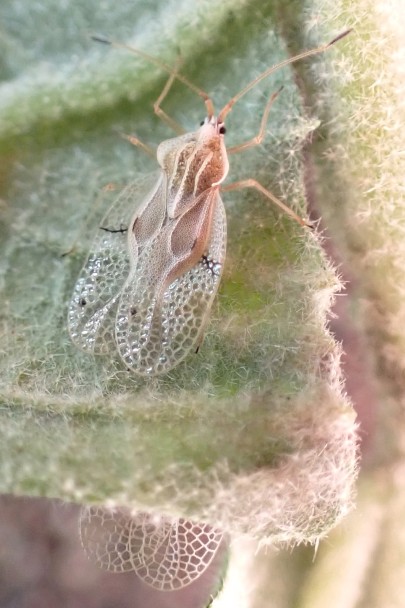
Woolly nightshade lace bug Gargaphia decoris
Weed biocontrol has been practised in AoNZ for nearly 100 years, beginning at the Cawthron Institute in Nelson in 1925. The earliest weeds explored as biocontrol targets were agricultural pests: blackberry, foxglove, gorse, ragwort, and one native plant, piripiri.
During the mid-20th century biocontrol faded into obscurity as new herbicides became available, but growing disillusionment with herbicides has led to a resurgence in biocontrol activity since the 1970s. Weeds targeted into the 1990s by the Department of Scientific and Industrial Research, and later Landcare Research, included gorse and ragwort (both for a second time), plus thistles, broom, hawkweeds, heather, mist flower, old man’s beard, and the only aquatic species tackled in AoNZ so far, alligator weed.
However, weeds still cost the country more than a billion dollars each year and threaten all of our ecosystems. Today the naturalised vascular flora of AoNZ (2,430 species) exceeds the native flora (2,414 species). This pool of potential new weeds continues to grow as more species continue to naturalise out of the more than 25,000 species of exotic plants already in the country.
Biocontrol is therefore more important than ever in attempting to reduce the impacts of some of the most serious, widespread weeds. This is reflected in the accelerating pace at which new biocontrol agents are being released.
We are currently progressing varying stages of biocontrol solutions for 18 weed species in AoNZ and 10 species in the Pacific, all concurrently. By world standards our success rate for establishing weed biocontrol agents is high – around 85%.
Current wide-ranging weed biocontrol work includes investigating a range of fungal pathogens for Chilean needle grass, old man’s beard, and Darwin’s barberry; a range of leaf-, flowerbud-, and root-feeding beetles for Chilean flame creeper, woolly nightshade, and yellow flag iris; a gall wasp for Sydney golden wattle; and a beetle to control air potato in Niue, among numerous other projects.
Dr Ronny Groenteman, a senior researcher at Manaaki Whenua, says it is painstaking work. “The biocontrol agent must be host-specific to the target weed, must be free of hitchhiking organisms such as gut pathogens or mites, and must survive being transported from overseas, being re-synchronised with the southern hemisphere season cycle and being reared in sufficient numbers in containment. Then it must also survive being released and establish a population big enough to control the target weed. These are all big asks for a biocontrol agent, and if one step fails, it’s back to the drawing board.”
But it’s worth it in the long run. For example, 40,000 out of 50,000 hectares of heather in Tongariro National Park have now been successfully controlled using heather beetles, which are native to northern Europe – a much better outcome for a World Heritage Site than chemical control. Biological control of nodding thistle, using two weevils and a gall fly, has resulted in an 80% overall decline of the weed, generating a benefit:cost ratio of 580:1 and a saving of at least $28 million to farmers every year. In addition, half of survey sites have either dramatically reduced their need to control nodding thistle or no longer need to manage it at all.
The biocontrol of St John’s wort, via two species of St John’s wort beetle, has resulted in a saving of nearly $930 million since the first introduction of the agents in the mid-20th century, and continues to provide savings of $15.5 million annually without any further investment. Indeed, it is estimated that savings provided by the St John’s wort biocontrol programme alone have more than paid for all weed biocontrol programmes undertaken in AoNZ so far.
These are strong arguments, enabling councils to justify continued investment in weed biocontrol.
Now our work is shifting gears again, with a new focus on whole-ecosystem outcomes. We are increasingly taking a holistic approach to weed management, placing it in terms of ecosystem outcomes rather than the presence/absence of the target weed. We aim to provide more informed approaches to weed control, and better decision-making on the application of control tools – including biological control – to ensure the best ecosystem outcomes.
Underpinning this is a new ‘trait-based’ framework for weed control, which evaluates the environmental impacts of co-occurring weeds that could be different from when those weeds occur alone. This is essential for risk assessment of new invasions, but also for management, which usually focuses on one weed at a time, though most ecosystems contain multiple weeds. It reduces perverse outcomes from weed control, such as new weeds replacing the old, or increased fire risk from dead vegetation.
Our goal is to fill evidence gaps and support decision-making needs for the management of any weed earlier in an invasion process. This supports uptake of the recommendations for tackling emerging weeds in the Parliamentary Commissioner for the Environment’s 2021 Space Invaders report.
This new focus has become achievable because it builds on lines of evidence and modelling tools that we have developed for established weeds in our past work. It has moved weed control from what is often viewed as being an intractable problem (too many species, overwhelming in scale) to a clearer prioritisation to deliver real gains for biodiversity and agriculture.
Our prioritisation tool for weed biocontrol targets is now being adopted more widely in AoNZ and overseas, and the relative performance index we have developed to inform risk assessment of candidate biocontrol agents is being adopted by Australia and explored by the USA.


